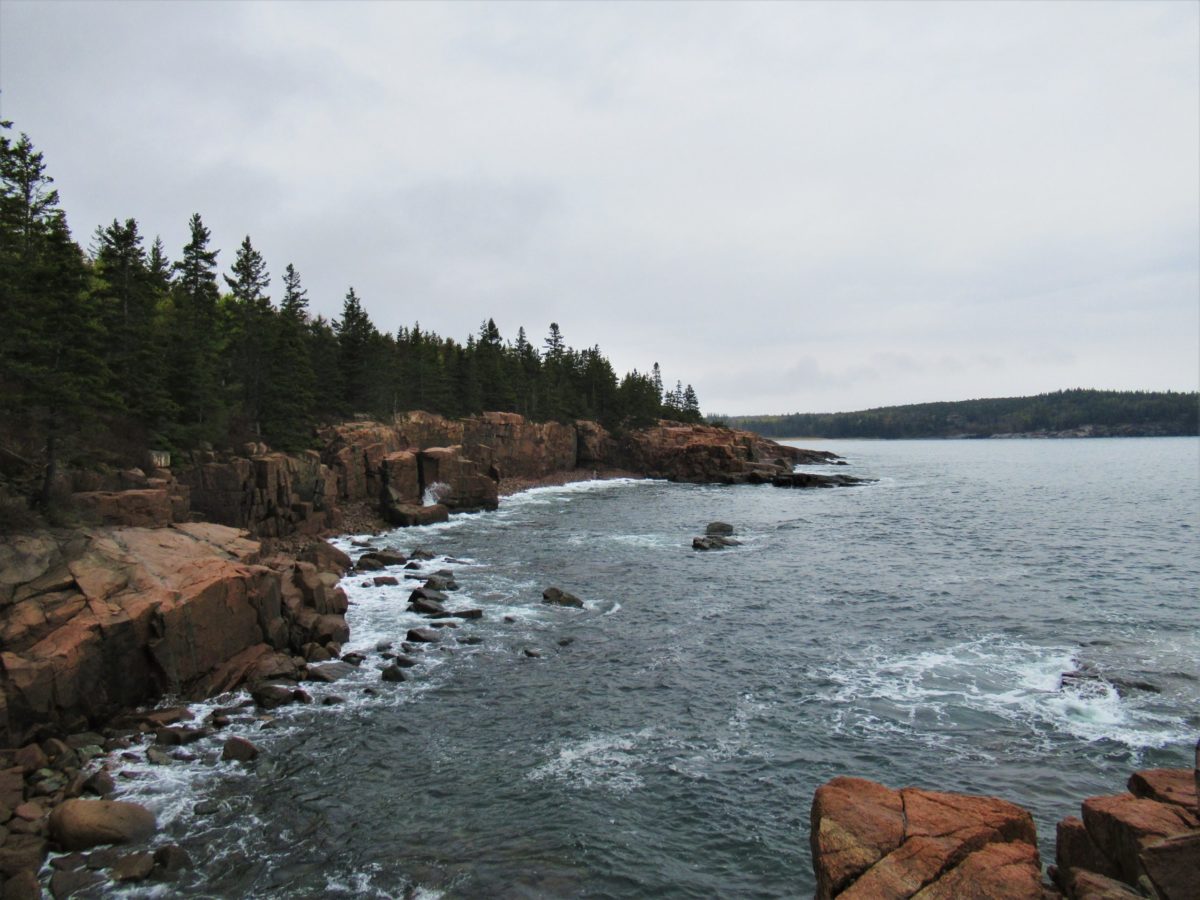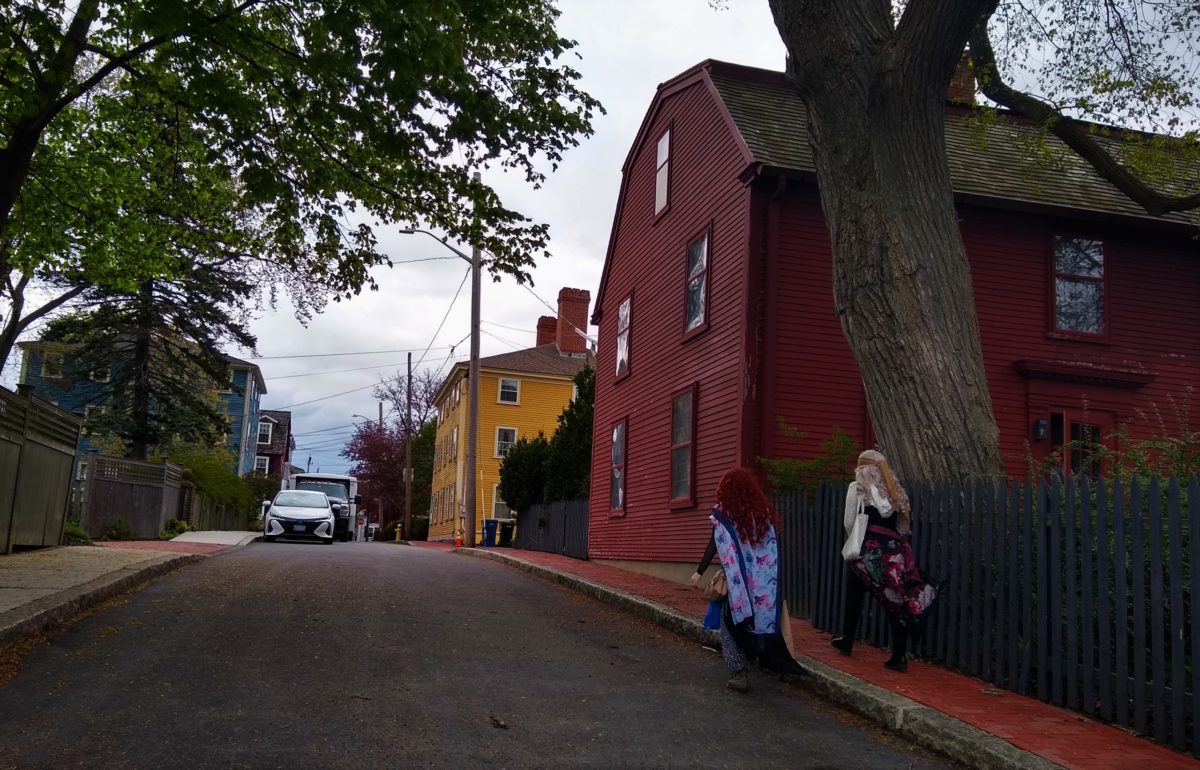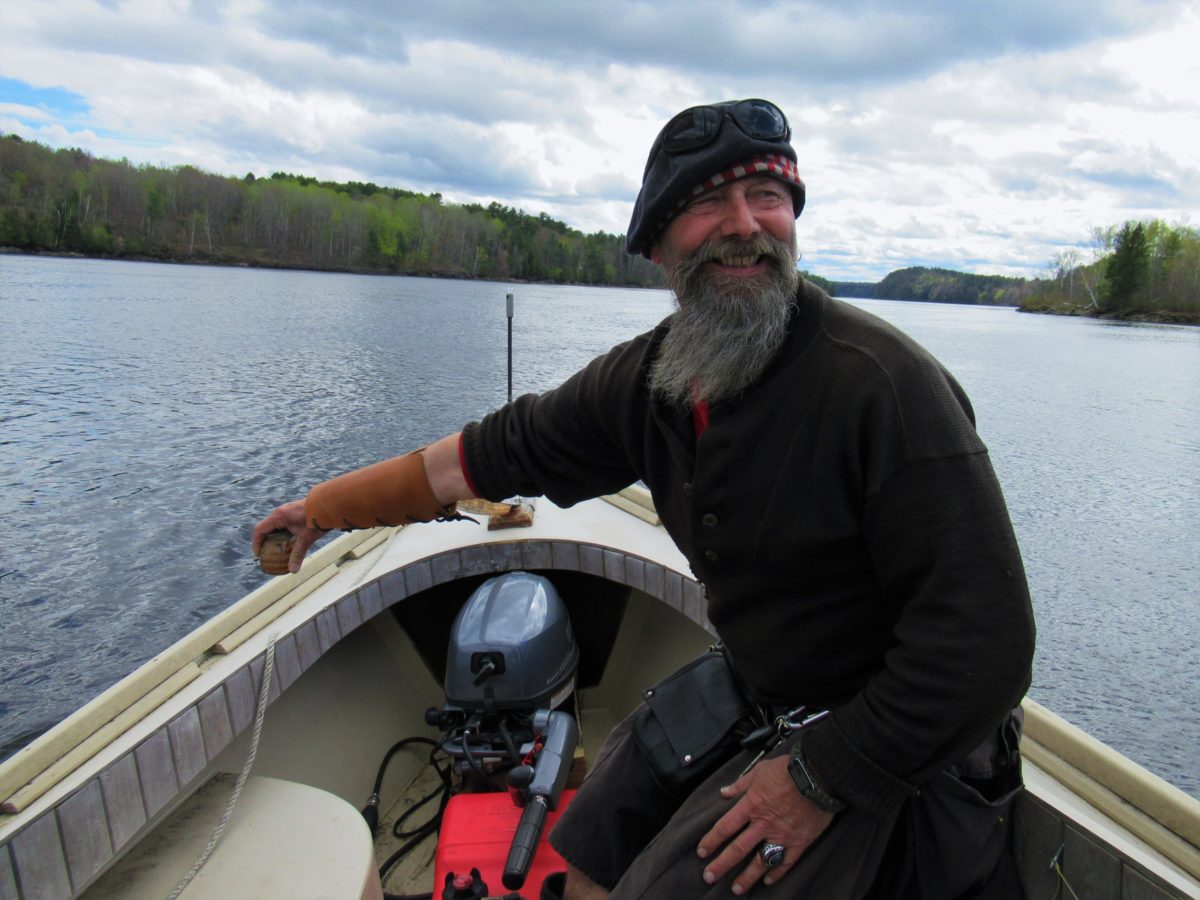By : Julia Thimberg Silfwerling
“That’s the sewer they say inspired that clown in Stephen King’s IT,” the pirate says as he steers us down the Penobscot River, which separates the two Maine towns of Bangor and Brewer.
We met captain Jack Lash Lanigan the night before at Nocturnem Draft House as he was smoking a slim cigar outside the bar on Main St. He is a bald man with big, Viking-esque beard and kilt. Yesterday he had topped it off with a coyote skin – head and all – worn like a cape. Happy to meet Swedes – he claims to have Swedish as well as Irish and Scottish ancestry – he invited us for drinks in the bar and to come along on his pirate “ship” the next morning.

Bangor, Maine is our final destination. We had traveled the American East Coast, cruising the I-95 in a black Nissan Rogue – a car that initially felt too big for us Europeans to drive – through twelve of the 14 states along it. It was a road trip of 17 days, 16 nights of bad or mediocre sleep, a handful of showers and backpacks full of dirty clothes. All the while our intentions had been set on the roaring, deep green waters of the Atlantic Ocean outside Maine’s forest-clad coast.
Traversing a long distance during a short amount of time on a student budget led to some improvisations. We slept a few nights in the car at rest stops along the highway or by the curb between pastel-coloured villas and the sea, crammed in with our blankets and pillows, preferably not getting murdered before dawn. A few times we checked in at cheap motels; one of us creating a make-shift bed on the 70’s carpet, like some burrowing animal, while the other two shared a bed after a bed-bug inspection. However, it was the nights in our two-person tent from Walmart that really mattered. Despite being small and freezing, it kept us homely and dry – once covered with an extra tarpaulin to keep out downpour. We used it at designated campgrounds, the majority owned by the National Park Service, and the further north we went, the less modern comforts did they provide.
After visiting Savannah, Georgia and Charleston, South Carolina we stopped for a longer time at Cape Hatteras National Seashore in North Carolina and Assateague State Park which stretches out over Maryland and Virginia. In the first, we stayed at a peaceful campground amongst the white sand dunes and dark green, spiky grass that rattled like autumn leaves in the wind. The May sun was burning during the day and the Milky Way was visible above during the night, the roaring sea never out of hearing distance. On the beach the rotting carcass of a whale rested, a big black lump being eaten by flies and sand-dwelling creatures.
In Assateague, we were the main course for the mosquitos. Big and hungry, they circled or camp, barely repelled by the smoke rising from the wet wood we used in our small bonfire. However, it wasn’t the mosquitos we had come to see. Assateague is famous for a much bigger animal: wild ponies.
Legend said that ponies first came to the island after a shipwreck long ago, but a more likely story told by a shop owner in the pretty little town of Chincoteague in Virginia, said that the ponies were brought to the island by settlers that didn’t want to pay tax on them.
Tourists flocked along the sides of the single road that runs through Assateague State Park, their cars gleaming like oversized bugs as they admired the ponies grazing amongst the shrubs. A park ranger marched back and forth like a guard dog, separating humans from animals, while visitors in Bermuda shorts and snapped some photos with their smartphones or expensive system cameras before getting back into their cars to move on, looking for something new to entertain them.
“It feels kinda fake,” my friend Gustav said, “like being at a zoo or a safari park or something.”
Disappointed, we left the road and walked south along the beach. After passing dozens of jeeps and fishermen, we turned inland, following a path through a shrubby forest and across muddy pools to finally emerge at a grassy swamp. This was more like it! A pack of ponies, from yearlings to elderly, peacefully grazing far away from the commotion by the road. As we admired them from a distance, the ponies lifted their furry heads to see if we had any food. When they realised we didn’t, they carried on with their lives.
We left Assateague to the smell of cold asphalt, wet forest, and horse shit to drive onwards to Washington, D.C. The temperatures had already changed, it felt as if we were driving away from the approaching summer and back into winter.
Washington, D.C. was slumbering this gray Sunday. The massive monuments – the Library of Congress, the Capitol, the Mall of America, the Washington Monument and the impressive Lincoln Memorial – symbolizes the only true religion of the United States: America. Surrounded by the ever-photographing tourists Abraham Lincoln sits on his throne, like a god from ancient Greece, and it seems like the legacy of the 16th president of the United States has turned him into something more than the mortal man he once was.

By midnight, Philadelphia, Pennsylvania welcomed us with freezing downpour. We checked into a hostel on 2nd Street, the old neighborhood, and went out to find a bar open past midnight. In the morning we made our way through this industrial city’s downtown, hiding from the rain inside the Benjamin Franklin Museum and the Independence Hall. However, before leaving Philly we had to pay tribute to one of its most famous heroes: Rocky Balboa. Singing Eye of the Tiger and running up the stairs outside the Museum of Art Philadelphia, we stopped at the top where a security guard pointed out a set of golden Converse footprints integrated into the stone, the exact location where the fictive boxer once stood. We had to stand there as well; arms raised towards the sky, paying tribute to a man that had never existed, yet somehow turned into a saint of America.
Onwards to Massachusetts, blasting Dropkick Murphy’s as we approached Boston. We breakfasted in the cafeteria of a monstrous building of concrete and glass at Harvard before heading downtown. The contrast between the slim and fashionable people walking across Harvard’s green campus the armed guards at the community college inside a giant concrete roundabout was a visual representation of the contrasts in this city, which managed to look both European and American at once with its old churches and brick buildings next to skyscrapers and green Starbucks logos. After walking the 2.5 miles Freedom Trail through the city – a trail designated to take visitors through the city’s history in a few hours – we had dinner at a bar hidden on the second floor up an alley where men were sitting quietly by the bar watching NHL while sipping on their beers.
 On the 13th day, we reached Salem, Massachusetts. Despite the notorious witch trials that happened here in the 17th century, the small town now attracts both tourists and modern-day witches, the most famous being practitioners of the Wicca religion. Souvenir shops, psychics and museums line the high street, making it a haven for those interested in the occult. By the Derby Waterfront District we met two young witches dressed in colour: long skirts and shawls, necklaces, flowing hair and doll-like make-up. Lisandre and June had driven from Quebec to buy herbs, books and trinkets in their favourite shops around town.
On the 13th day, we reached Salem, Massachusetts. Despite the notorious witch trials that happened here in the 17th century, the small town now attracts both tourists and modern-day witches, the most famous being practitioners of the Wicca religion. Souvenir shops, psychics and museums line the high street, making it a haven for those interested in the occult. By the Derby Waterfront District we met two young witches dressed in colour: long skirts and shawls, necklaces, flowing hair and doll-like make-up. Lisandre and June had driven from Quebec to buy herbs, books and trinkets in their favourite shops around town.
“I’ll do my best to be a Wicca,” Lisandre explained in her French accent, “but it is hard. I don’t have a teacher so all I’ve learned is from books, but every book says different things.”
Abandoning the I-95, US Route 1 took us towards the coast. Bath, Maine, on the Kennebec River drew us in with its cute high street lined by brick buildings and bookstores, the river reflecting the opposite shore like a mirror. In Boat Builder’s Pub, a cellar bar smelling of cigarettes and warm beer, a war veteran who served in Somalia during the ’90s taught us some American bar-etiquette:
“I know you guys are not from around here,” he said, “but you never talk about politics in an American pub.”
To the sound of rock music, voices and billiard balls slamming, he explained that this is because one can never know who is listening and what that person might do if they disagree.
Around 1 am we finally reached Acadia National Park and searched for our camping spot in a maze of roads and pine trees at the Blackwood Campground. Eventually we found it and pitched our tent in the compact dark beneath the pines. Waking up to the smell of resin and chilled earth, our muscles ached after another cold night. Here it was early spring again, young sprouts on the ground and tiny buds on the trees: it felt like one of those days when you can hear the buds pop open.
Despite it being early in the season, the most popular park in the North East was already crowded. We climbed Mt. Penobscot (1194 ft) – by Jordan Pond, the clearest lake in the park – from which windy top we could gaze over deep green mountains and the Atlantic which melted into the infinite sky. Because of the ice from the last ice age reached this far south, the northern side and the tops of the mountains are smooth, rounded like the backs of the Eastern Chipmunks who inhabits them, while the southern sides are vertical and sharp, broken stone creating a much harder descent than the climb up.
It was raining the next day as we stood by the sea. The conifers, aspen and birch trees reached all the way to the edge of the land, where vertical red cliffs fell into the sea. The ocean was deep green, majestic as it roared and clashed against the cliffs, spraying a fine mist of salty water. Somehow the clang of a buoy overbore the noise of the sea and we lingered a few minutes extra, breathing the kelp smelling air.
When we checked into an AirBnB in Exeter, Maine later that day the first hot shower in two weeks was a luxury. Horses that wanted cuddles and apples grazed in the pastry outside the small apartment and two crazy pugs wanted our attention, but to be inside was a necessary relief. That evening we drove 30 minutes to Bangor to look upon one of Stephen King’s houses. Gustav admiringly touched the metal fence as he glanced at the dark window of the red wooden building with its pointy tower that belongs to his literary hero.

It was that evening we met Captain Jack Lash Lanigan, and this morning we joined him by his boat Milady. His real name is Nelson, and he was born and raised in Bangor, despite claiming to be an Irish pirate. He is a retired veteran who joined a pirate crew after a divorce and hiking the Appalachian trail (the world’s longest hiking-only trail with its 2,200 miles) in a kilt. He tells us that the Penobscot River, named after the Penobscot tribe, is a success story in cleaning nature from pollution. It was once heavily contaminated, a result of Bangor’s history as a leading lumber port, but has been cleaned up and conserved enough to have bald eagles nesting in the trees along it. As we pass one of these majestic birds, he shouts a greeting.
“It was my brother’s favorite bird,” he explains, looking sad as he mentions his late brother, “I feel close to him when I see them, so I always call his name.”
Passing the sewer pipe that supposedly inspired IT’s sewer in the novel, Nelson told us how Stephen King’s fame has provided much tourism for the town. Because this has become another of those places to which modern pilgrims come to pay tribute to their saints. Driving north through the United States, we had witnessed this new form of worship. As we embrace this rising pop-culture religion ourselves, one can’t help to wonder what these places will symbolize in the future. Will they have outgrown the stories that originally made them famous, or will they have disappeared, swallowed by a merciless, fast-moving world where nothing lasts forever?
Julia Thimberg Silfwerling is a Swedish freelance journalist currently living in London.



